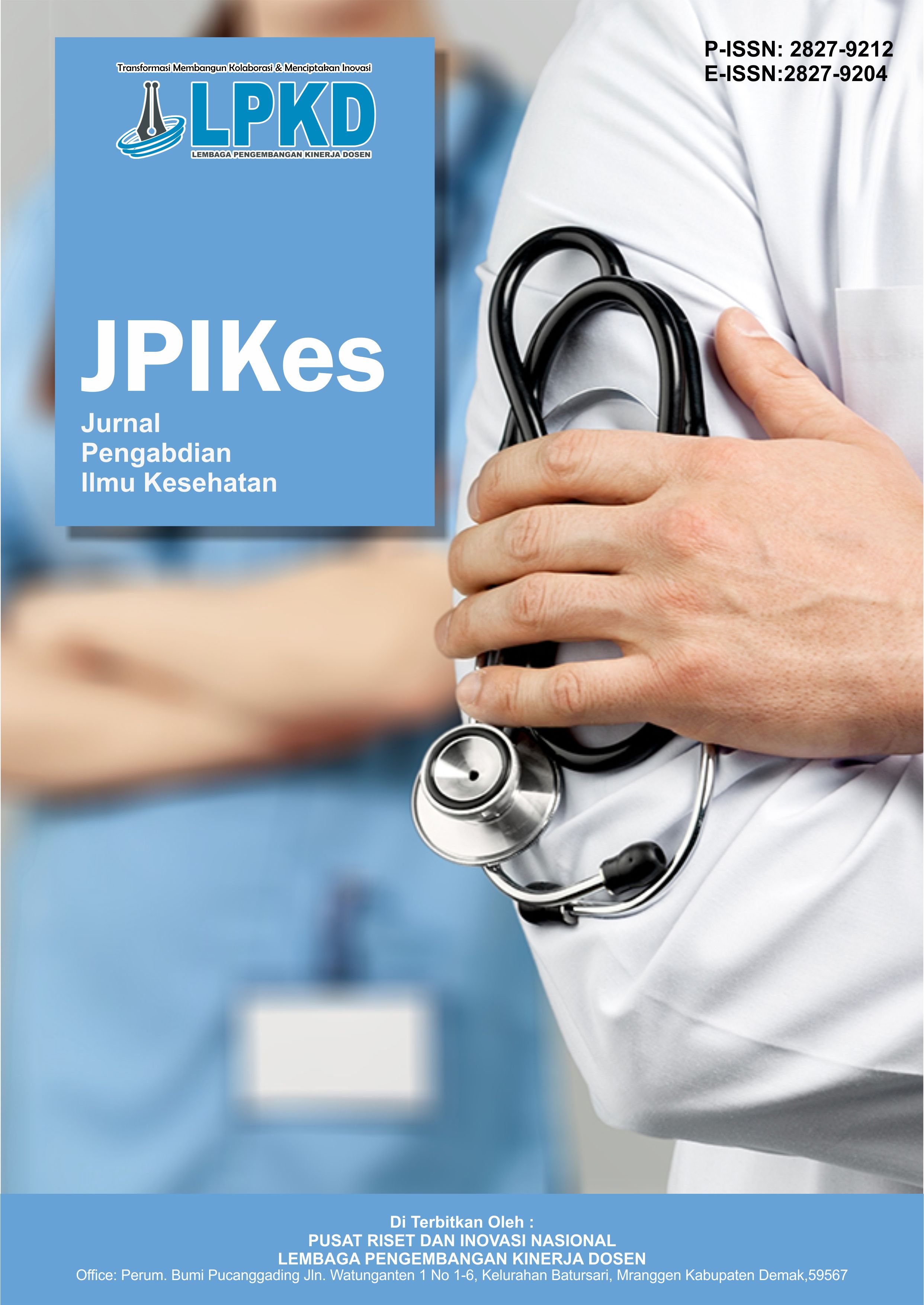Lama Penggunaan KB Suntik 3 Bulan Signifikan Meningkatkan Resiko Gangguan Menstruasi di TPMB Widya Putri
DOI:
https://doi.org/10.55606/jpikes.v5i2.5987Keywords:
3-month injection, Contraceptive acceptors, Contraceptive device, Duration of use, Menstrual disordersAbstract
Menstrual irregularities may arise after long-term use of injectable contraception. Menstrual disorders are characterized by abnormal bleeding during the menstrual cycle, as shown by the duration of the monthly cycle, the length of the menstrual period, and the volume of menstrual blood. Changes in the menstrual cycle affect physical, psychological, social, and spiritual dimensions, reduce the quality of life, and may lead to long-term problems if inadequately managed. Prolonged use of tri-monthly injectable contraceptives is recognized to cause changes in the levels of estrogen and progesterone hormones within the body. This impairs endometrial function and results in histological changes that cause menstrual problems. This study aims to determine the relationship between the length of usage of three-monthly injectable contraceptives and abnormal menstruation at TPMB (Independent Midwifery Practice) Widya Puri. This research employed an analytical study utilizing a cross-sectional methodology. The study sample comprised of 100 mothers attending a follow-up appointment for a three-monthly injectable contraception. The methodology employed was purposive sampling. Data collecting methods employed questionnaires and observation sheets, which were analyzed using univariate analysis and chi-square tests. The data showed that 84 mothers, representing 84.0%, had a duration of use more than one year. The majority of responders encountered menstruation problems. Amenorrhea occurred in 55 individuals (55.0%), while menstrual problems were the least prevalent. Hypomenorrhea occurs in 6 individuals, representing 6% of the population. The statistical analysis employing the Chi Square test obtained a p-value of 0.000 (<0.05). This is a significant relationship between the duration of 3-month injectable contraceptive use and menstrual problems. In this case, it may be stated that the research hypothesis Ha is accepted whereas Ho is rejected, therefore confirming the validity of the research hypothesis. Furthermore, it may be inferred that a relationship exists between the duration of 3-month injectable contraceptive usage and menstruation disorders in TPMB Widya Puri.
Downloads
References
Handayani, M.,S., Maharani, P., K. (2017). Perbedaan Siklus Menstruasi pada Akseptor Kontrasepsi Hormonal Suntik 3 Bulan dan Pil Kombina di Puskesmas Kassi-Kassi Makassar. Jurnal Ilmu Kebidanan dan Kesehatan. Vol.1 No.2.
Hartati, S., & Desmariyenti. (2020). Hubungan Lama Penggunaan KB Suntik 3 Bulan Dengan Ketidakteraturan Siklus Menstruasi di Puskesmas Simpang Tiga Pekanbaru Tahun 2017. 5(3), 564–568.
Juniastuti, V., Ratnawati, A.E. and Margiyati, M. (2023) ‘Lama Pemakaian Kontrasepsi Suntik Dmpa (Depo Medroksiprogesteron) Dengan Gangguan Menstruasi Pada Aseptor Kb Suntik 3 Bulan’, Jurnal Ilmu Kebidanan, 9(2), pp. 97–101. Available at: https://doi.org/10.48092/jik.v9i2.207
Mulyandari, A., & Noviyanti. (2019). Hubungan Penggunaan Kontrasepsi dengan Siklus Menstruasi pada Akseptor KB Suntik. Cakrawala Kesehatan, x(2).
Nasution, I. W. A., Muthia, M., & Meinarisa. (2023). Hubungan Penggunaan KB Suntik Terhadap Siklus Menstruasi Dan Peningkatan Berat Badan Ibu Di Wilayah Kerja Puskesmas Simpang IV Sipin Kota Jambi. HIJP (Health Information Journal Penelitian), 15(1), 10–27. https://medium.com/@arifwicaksanaa/pengertian-use-case-a7e576e1b6bf
Notoadmodjo. (2018). Metode Penelitian Kesehatan. Pt. Rineka Cipta.
Nuryadi, Tutut Dewi Astuti, Endang Sri Utami, M. B. (2017). Dasar-Dasar Statistika Penelitian.
Sagita, L., Rudini, D., Keperawatan, P. S., Kedokteran, F., & Jambi, U. (2022). Gambaran Efek Samping Penggunaan Alat Kontrasepsi Hormonal Pada Akseptor Kontrasepsi Hormonal di Kota Jambi kontrasepsi. 1.
Setyawan, D. A. (2022). Buku Ajar Statistika Kesehatan Analisis Bivariat Pada Hipotesis Penelitian. In Angewandte Chemie International Edition, 6(11), 951–952. (Vol. 2, Issue February).
Sheika, N., Nour., S. (2023). The Impact of Three Months of Use of Family Planning Injections on Spotting Incidents in Family Planning. International Journal of Advanced Health Science and Technology, vol. 3, no. 4, pp. 241-245.
Sinaga, R. A. P. (2021). Hubungan Lama Pemakaian KB Suntik 3 Bulan Dengan Gangguan Menstruasi di BPS D Purba Desa Girsang. Jurnal Ilmiah Kesehatan, 13(1), 13–24. https://doi.org/10.37012/jik.v13i1.460
Sugiyono. (2019). Metode Penelitian Kuantitatif, Kualitatif, Dan R&D. Alfabeta.
Tantri, L., Dwijayanti, L. A., & ... (2022). Gangguan Menstruasi Pada Penggunaan Kontrasepsi Hormonal (Pil, Suntik, Dan Implan) Di Puskesmas Sukasada I. Prosiding …, 197–205. http://simkesnas.stikesbuleleng.ac.id/index.php/simkesnas/article/view/31%0Ahttps://simkesnas.stikesbuleleng.ac.id/index.php/simkesnas/article/download/31/27
Wahyu, R. (2018). Hubungan Lama Pemakaian Alat Kontrasepsi Suntik 3 Bulan Dengan Gangguan Menstruasi Pada Akseptor Kb Suntik 3 Bulan Di Klinik Sabarita Tanjung Beringin Kecamatan Hinai Kabupaten Langkat Tahun 2018. Jurnal Kebidanan, 1–106.
Downloads
Published
How to Cite
Issue
Section
License
Copyright (c) 2025 Jurnal Pengabdian Ilmu Kesehatan

This work is licensed under a Creative Commons Attribution-ShareAlike 4.0 International License.









